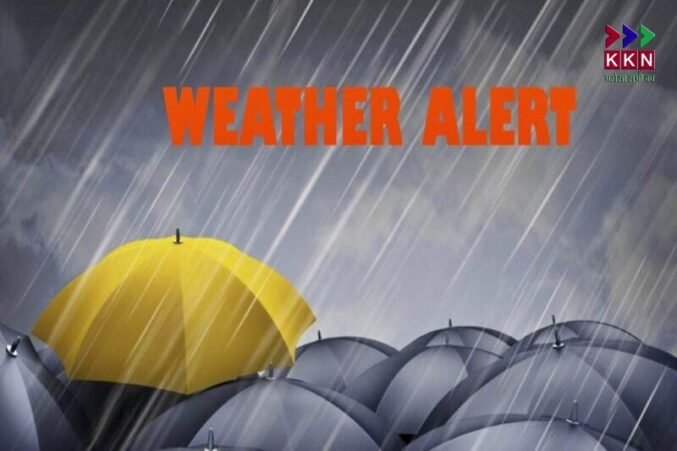
Bihar is witnessing widespread destruction due to relentless monsoon rains. Several districts including Patna, Muzaffarpur, and Vaishali have been placed under red alert. With bridges collapsing and roads being washed away, connectivity to remote areas has been severely affected. Farmers across the state are facing severe agricultural losses, and normal life has come to a standstill in many regions.
Monsoon System Intensifies Over Northern Bihar
The monsoon trough has become more active over northern Bihar. This system is currently moving through the skies above Muzaffarpur and Purnia. As a result, almost the entire state is experiencing extreme rainfall. On Saturday, heavy rains were recorded in Patna, Muzaffarpur, Vaishali, and surrounding districts. In Patna and Pataliputra railway stations, water levels rose to two to three feet, disrupting transportation.
In Jamui, a major bridge collapsed, cutting off connectivity to several villages. Similarly, in Lakhisarai, a major road was washed away due to rising water levels. These incidents highlight the devastating impact of continuous heavy rainfall across many parts of Bihar.
Sunday Brings Continued Downpour and Flood Threat
As Sunday progresses, the state continues to face severe weather conditions. Since morning, torrential rain has been lashing many districts. The India Meteorological Department (IMD) has predicted heavy to extremely heavy rainfall in as many as 20 districts today. A danger alert has been issued, urging residents to stay cautious and indoors wherever possible.
Districts Likely to Receive Extreme Rainfall Today
The districts of West Champaran, East Champaran, Sitamarhi, Sheohar, Madhubani, Darbhanga, Muzaffarpur, Siwan, and Supaul are likely to witness extremely heavy rainfall. In addition, districts such as Gopalganj, Buxar, Bhojpur, Patna, Vaishali, Samastipur, Araria, Kishanganj, Purnia, and Khagaria are expected to receive very heavy rainfall.
Apart from these, other districts are also under alert due to the potential for torrential rainfall. This widespread monsoon activity is expected to continue for the next few days.
Monsoon Mayhem Expected to Last for Three More Days
According to IMD forecasts, the active monsoon systems will continue to impact large parts of Bihar for at least the next three days. Extremely heavy rainfall is likely in northern districts like Supaul, Madhubani, and Darbhanga. Kishanganj, Araria, Purnia, Katihar, Bhagalpur, and Samastipur are also expected to experience intense downpours.
These weather conditions could result in a rapid rise in water levels in major rivers of northern Bihar. Low-lying areas are at risk of waterlogging and possible flash floods. Authorities are monitoring the situation closely, but the risk of further damage remains high.
Massive Crop Losses and Transportation Disruption Reported
The continuous rainfall has led to widespread damage in many parts of the state. In Patna, areas like Pandarak, Athmalgola, Mokama, Ghoswari, and Barh blocks have seen thousands of acres of paddy crops submerged under water. Farmers are bearing heavy losses, with no immediate relief in sight.
Even the capital region is not spared. Several streets in Patna are flooded, with water levels rising up to three feet in some areas. This has brought traffic and public movement to a near halt.
In Jamui, the Ulai river is in spate, cutting off contact with several villages. In Banka, approximately 20 feet of a major road has been washed away by floodwaters. Many other districts are facing similar challenges, with emergency services stretched thin across the region.
Weather Forecast and Temperature Across Major Cities
The situation remains grim, and here’s a look at Saturday’s maximum and minimum temperatures along with air quality index (AQI) data for major cities in Bihar:
Patna: Maximum 29.9°C, Minimum 26.8°C, AQI 57
Muzaffarpur: Maximum 31.2°C, Minimum 26.3°C, AQI 40
Gaya: Maximum 29.0°C, Minimum 26.6°C, AQI 41
Purnia: Maximum 31.0°C, Minimum 26.9°C, AQI 39
Bhagalpur: Maximum 31.1°C, Minimum 27.3°C, AQI 45
These temperatures indicate relatively cooler days due to consistent rainfall, but air quality remains moderate to good in most cities.
Residents Urged to Remain Alert
Authorities have appealed to residents in affected districts to remain vigilant. Due to the risk of lightning and severe thunderstorms, people are advised to avoid open areas and take shelter indoors. Precautionary advisories have been issued, particularly in flood-prone and low-lying zones.
Emergency control rooms are functioning around the clock to address public concerns. Disaster management teams are on standby in the most vulnerable districts to respond to any crisis quickly.
Impact on Infrastructure and Connectivity
The heavy rainfall has not only impacted agricultural productivity but has also caused serious damage to infrastructure. Washed-out roads and damaged bridges are making relief operations difficult. Local administration is assessing the damage and working to restore connectivity where possible.
Electricity supply in several rural and urban areas has been affected due to submerged transformers and downed power lines. Communication networks in flood-hit areas are also experiencing disruptions.
Looking Ahead: What Next for Bihar?
As the monsoon continues to lash Bihar, the next 72 hours are critical. Meteorological data points to the possibility of continued heavy rainfall in multiple districts. Residents are advised to track weather updates closely and adhere to safety advisories.
Government authorities have stepped up efforts to minimize damage and provide aid to affected populations. Relief materials including food, water, and medical supplies are being dispatched to cut-off areas. However, the extent of damage suggests a long road to recovery, especially for the farming community.
Bihar is in the grip of one of the harshest monsoon phases in recent years. With red alerts issued in many districts, and severe damage already reported, the situation remains highly sensitive. Continuous rain, rising river levels, collapsing infrastructure, and the suffering of farmers paint a grim picture. The administration and disaster management authorities are actively involved, but the scale of the crisis requires ongoing vigilance and preparedness from both officials and residents alike.


